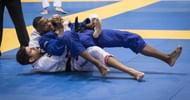The 5th Asian Indoor and Martial Arts Games will be a celebration of the rich tradition of combat practices that evolved in millennia of Asian culture, when the action gets underway in Ashgabat in September.
As many as nine different Martial Arts will take centre stage when the Ashgabat 2017 competition starts on 16 September, a day before the Opening Ceremony, in the state-of-the-art Olympic Stadium.
Once practised by people around the world for self-defence, Martial Arts have gone on to become much more than that in today's world. A constant source of entertainment and mental and spiritual development, the proverb "the bigger they are, the harder they fall" never served as a greater source of motivation than in this modern age.
With more than 6,000 athletes expected to participate in the Games held in the Turkmen capital, Martial Arts will capture the attention of fans as well as a global television expected to run into the billions.
Of the nine Martial Arts in the programme, three are different variants of Wrestling, a sport that has always captivated fans in the Central Asian region in particular, from domestic competition to the Olympic Games, with its physicality and technical style.
Traditional Wrestling is the most widespread version comprising multiple disciplines that may or may not include the use of a belt. Traditionally, this branch is focused on the use of the lower body. Hosts Turkmenistan have always performed well in this category.

Belt Wrestling, one of the oldest forms of the sport, promises to be one of the most popular sports at the Games. The term belt is key, as competitors aim to knock each other off their feet but only holding a belt tied around their opponent's waist.
The final Wrestling event is the one that is most commonly known around the world, with participants grappling on a circular mat. Featured at the Olympic Games, it has two categories, Freestyle and Greco-Roman, with grapplers allowed to focus their attacks on both the upper and lower body in the former, with only the upper body to be gripped and attacked in the latter.
This event will see participants who have impressed on the world stage at both the World Championships and the Olympics, and will have a very high standard of competition, with India and Turkmenistan represented in great numbers.
Meanwhile, Taekwondo, a Martial Art considered the national sport of Korea, has now assumed a hugely popular global perspective and will see extensive participation at the 5th Asian Indoor and Martial Arts Games in Ashgabat.
Now a popular Olympic sport, competitors will battle it out across two disciplines - Kyorugi and Poomsae, with the former consisting of seven different weight categories, and the latter involving both individual and team events. Apart from Korea, China and Iran will be among the favourites for Taekwondo medals at the Games.
A unique sport at the Games is SAMBO, a dynamic Martial Art developed well over 90 years ago, primarily as an unarmed self-defence system for the Soviet Army Special forces. SAMBO has over the years transformed into an extremely popular combat sport practised across the five continents by men and women of all ages. The sport has seen the likes of living legends such as Fedor Emilyanenko (known as the Last Emperor) and Khabib Nurmagomedov, a multiple World Combat SAMBO champion, who has risen to become a force to be reckoned with in the professional Mixed Martial Arts arena today.
SAMBO incorporates the best and most effective combat techniques drawn from oriental martial arts such as Judo, Jiu Jitsu, Aikido and Karate and has combined the same with a variety of locks and submission techniques of Traditional Slavic and Soviet wrestling styles. SAMBO will see very strong representation from Turkmenistan, who did well at the recent Asian Sambo Championships.
Another popular sport at the Asian Indoor and Martial Arts Games will be Muaythai, a unique form similar to Kickboxing that originated from Thailand and involves stand-up striking and clinching. The sport is characterised by the use of shins, elbows, knees and fists.
An ancient Uzbek martial art, Kurash is another competition unique to certain parts of Asia, and can be defined as Wrestling using the help of a towel to throw opponents off their feet. Originally used as a form of entertainment at major gatherings, the sport advocates the use of fair means to reach the end, and is growing in popularity.
The vastly popular discipline of Kickboxing originated from a combination of Muaythai and Karate, with the competitors boxing with gloves while kicking with their bare feet. A sport in which the participants also wear protective head gear, it is becoming very common, and is also used as a fitness exercise. The sport, which has seen a lot of evolution, will see fierce competition at Ashgabat 2017.
One of the more keenly anticipated sports at the Games will be Jiu Jitsu, a sport focused on the gentle and smart manipulation of one's own strength. It was developed in Japan as a means to counter opponents wearing armour without any weapons.

Turkmenistan are known to be very strong in the sport and will look to make the most of home advantage to win medals, with Japan, the UAE and Jordan expected to be their biggest challengers.
The Asian Martial Arts Games, an event that started in 2009, were merged with the Asian Indoor Games to create the Asian Indoor and Martial Arts Games, a joint celebration of some of the most popular sports in the continent.
The Games will be a celebration of the rich culture of self-defence and fitness cultivated in different parts of Asia, with emphasis on ensuring that these Martial Arts are not lost whilst also giving due recognition to skilled athletes who are some of the world’s finest practitioners of these sports.